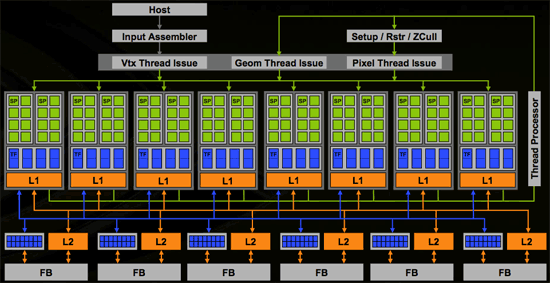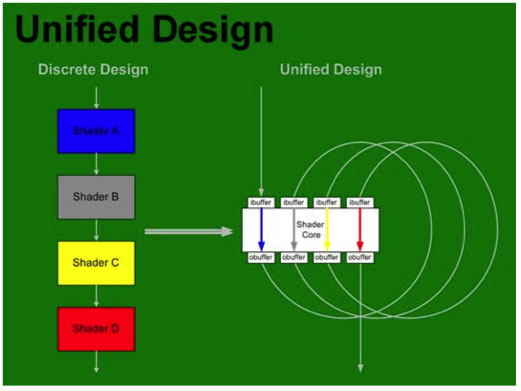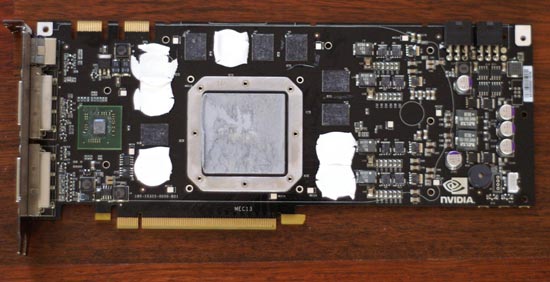NVIDIA's GeForce 8800 (G80): GPUs Re-architected for DirectX 10
by Anand Lal Shimpi & Derek Wilson on November 8, 2006 6:01 PM EST- Posted in
- GPUs
G80: A Mile High Overview
Now that we know a little more about the requirements and direction of DX10, we can take a deeper look at where NVIDIA has decided to go with the architecture of G80. We will be seeing a completely new design based around a unified shader architecture. While DX10 doesn't require a unified architecture, it certainly does make a lot of sense to move in that direction.
Inside G80, vertex, geometry, pixel shaders and more (more on this later) are all able to run on the same set of execution resources. In order to make this happen, the shader core needed to be made more general purpose and suitable for multiple usage scenarios. This is much like what we are used to seeing on a CPU, and as time moves on we expect these similarities to increase from both the CPU and GPU side. The design NVIDIA has come up, while very complex and powerful, is quite elegant. Here's a look at the block diagram for G80:

The architecture is able to use thread management hardware to dispatch different types of instructions on to the shader core. As vertices complete, their output can be used as input to geometry shaders back at the "top" of the shader core. Geometry shader output is then used as input to pixel shaders. Here's a quick conceptual representation of what we are talking about:

The sheer size of G80 is absolutely amazing; while NVIDIA wouldn't disclose exact die sizes let's look at the facts. The G80 chip is made up of 681 million transistors, more than a single core Itanium 2 or the recently launched Kentsfield, but manufactured on an almost old 90nm process. As a reference point, ATI's Radeon X1900 XTX based on the R580 GPU was built on a 90nm process yet it featured only 384 million transistors. NVIDIA's previous high-end GPU, the G71 based GeForce 7900 GTX was also built on a 90nm process but used only 278 million transistors. Any way you slice it, this is one huge chip. Architecting such a massive GPU has taken NVIDIA a great deal of time and money, four years and $475M to be exact. The previous record for time was almost 3 years at a lesser amount, but NVIDIA wouldn't tell us which GPU that was.

Intel's Quad Core Kentsfield on top, G80 on bottom
Despite very high clock speeds on the die and a ridiculous 681 million transistor count, power consumption of NVIDIA's G80 is quite reasonable given its target; on average, a G80 system uses about 8% more power than one outfitted with ATI's Radeon X1950 XTX.
You really start to get a sense of how much of a departure G80 is from previous architectures when you look at the shader core. Composed of 128 simple processors, called Stream Processors (SPs), the G80 shader core runs at a very high 1.35GHz on the highest end G80 SKU. We'll get into exactly what these stream processors are on the coming pages, but NVIDIA basically put together a wide array of very fast, specialized, but simple processors. In a sense, G80's shader core looks much like Cell's array of SPEs, but the SPs here are not nearly as independent as the SPEs in Cell.
Running at up to 1.35GHz, NVIDIA had to borrow a few pages from the books of Intel in order to get this done. The SPs are fairly deeply pipelined and as you'll soon see, are only able to operate on scalar values, thus through simplifying the processors and lengthening their pipelines NVIDIA was able to hit the G80's aggressive clock targets. There was one other CPU-like trick employed to make sure that G80 could have such a shader core, and that is the use of custom logic and layout.
The reason new CPU architectures take years to design while new GPU architectures can be cranked out in a matter of 12 months is because of how they're designed. GPUs are generally designed using a hardware description language (HDL), which is sort of a high level programming language that is used to translate code into a transistor layout that you can use to build your chip. At the other end of the spectrum are CPU designs which are largely done by hand, where design is handled at the transistor level rather than at a higher level like a HDL would.
Elements of GPUs have been designed at the transistor level in the past; things like memory interfaces, analog circuits, memories, register files and TMDS drivers were done by hand using custom transistor level design. But shaders and the rest of the pipeline was designed by writing high level HDL code and relying on automated layout.
You can probably guess where we're headed with this; the major difference between G80 and NVIDIA's previous GPUs is that NVIDIA designed the shader core at the transistor level. If you've heard the rumors of NVIDIA building more than just GPUs in the future, this is the first step, although NVIDIA was quick to point out that G80 won't be the norm. NVIDIA will continue to design using HDLs where it makes sense, and in critical areas where additional performance or power sensitive circuitry is needed, we'll see transistor level layout work done by NVIDIA's engineering. It's simply not feasible for NVIDIA's current engineering staff and product cycles to work with a GPU designed completely at the transistor level. That's not to say it won't happen in the future, and if NVIDIA does eventually get into the system on a chip business with its own general purpose CPU core, it will have to happen; but it's not happening anytime soon.
The additional custom logic and layout present in G80 helped extend the design cycle to a full four years and brought costs for the chip up to $475M. Prior to G80 the previous longest design cycle was approximately 2.5 - 3 years. Although G80 did take four years to design, much of that was due to the fact that G80 was a radical re-architecting of the graphics pipeline and that future GPUs derived from G80 will have an obviously shorter design cycle.











111 Comments
View All Comments
Sharky974 - Thursday, November 9, 2006 - link
The new features of DX10 stuff was captivating at first, but quickly grew tiresome and needlessly complex. The IQ comparisons the same thing, some simplicity is needed here. Tell us in a nutshell what looks better and why. The mouse over pictures are well nigh useless as well, and all look like crap. Whatever needs to be changed to get the IQ point across, needs to be changed already, I'm guessing 200 zoom is a problem for starters.Then who's bright idea was it to only test one resolution, through the whole article?
Then who's bright idea was it to dedicate just as many graphs as performance, one per game, to not only power draw, but the even more useless performance per watt? Meaning 66% of your data graphs, in an article about a paradign changin, long-anticipated, brand new GPU, are related to the power usage of the card. Are you electric workers monthly.com now?
I am very surprised more of the comments weren't negative, this review was a total failure.
And yeah, what's with all the non-standard resolution testing? All the big sites like H, Anand, and FS go round and round talking about the incredible depths they go to get the bottom of real world performance as it relates to the real world, average user, and then you guys use stupid resolution likes 1280X960 (FS uses that particular one), that nobody on earth uses, regularly! It's really, really stupid. Hell for that matter, nobody uses 1600X1200 or any non-LCD native res anymore either, yet those are all staples of any review, and so these "real world" articles aren't very real world at all. But that's somewhat of a tangent issue, and I actually dont mind a lot of different resolutions tested, just as long as the big common ones are hit (which is not always the case)
DerekWilson - Friday, November 10, 2006 - link
I'm always working on bringing down the complexity of my explainations. It's one of my weak points as a writer. It's difficult for me to take something and present it at a high level that doesn't reflect exactly what the thing is. Analogies are great -- I like them -- but I have a hard time using them because I can't ever think of analogies that are accurate enough.Any suggestions you have for helping me explain things completely, accurately, effectively, and (especially) in the most straight forward manner possible are very welcome.
As for the IQ comparisons -- these were much more simplified than I had intended (because Anand told me we couldn't do rollovers with 40 images on one page -- it would load too slow). This is our version of putting things in a nutshell. I could get to the point faster though --
IQ:
gamma correct aa is great for edges, but it causes problems with thin lines and transparency/adaptive AA making textures look mushy. transparency/adaptive aa are great but have a large performance hit -- except in 8800 which keeps these features playable and offers higher IQ. CSAA is great at brining higher AA levels to edges, but the loss of Z data at the sub-pixel level makes it less effective at solving the thin line problem than equivalent MSAA modes. The roll overs illustrate all this.
Thats as simple as I can make it -- I hope it helps.
We did not only test at one resolution -- In every game we tested at 1600x1200, 1920x1440, and 2560x1600. In oblivion we tested at 1280x1024 as well.
All our resolution data was in the last graph on each page -- resolution scaling. There are two graphs per page on performance. As you can see, at resolutions below 2560x1600, the 8800 GTX is almost over kill.
1600x1200 is a standard LCD panel resolution and has been for quite some time. It's actually quite affordable now as well. 1280x1024 (while popular) is often too low to matter in a high end performance analysis piece (and where it did matter we tested it). 1920x1440 is a 4:3 resolution that will give 1920x1200 panel owners a very good idea of performance (differnce is usually under 5% in many games). 2560x1600 is a standard resolution for 30" LCD panels.
I can understand being upset if you missed the performance data at other resolutions, but it seems like the rest of your complaints are that we put too much data in the article. I doubt this will change in the future, but is there anything else we could have done to make this article better? We are very willing to listen to feedback, especially on articles as big as this.
Thanks,
Derek Wilson
flexy - Friday, November 10, 2006 - link
>>>complaints are that we put too much data in the article. I doubt this will change in the future,
>>>
i doubt you can make it RIGHT for everyone...however i share the opinion w/ MOST that it is an excellent review. TOO much data is seldom bad, NOT on a site where you can expect geeks and nerds digging every bit of information :)
I remember times when reviews where FAR less detailed...and what can be better than going in-depth into AA/AF modi, showing their differnce in detail ? I think this was right on and i value such in-depth coverage !
The DX10 coverage MAYBE was "too much info" for some...but then legitimate IMHO. We're talking about totally new h/w architecture, totally new and revamped DX API and the first hardware supporting it..so it was defintly a good place to cover this.
Also...you always have the option to skip parts of a review...and the MORE detailed it is...the more it is a helpful resource (also later) to come back and read up. You dont need to comprehend any bit of information at once, but it's good to know it's there.
my $0.2
jiulemoigt - Thursday, November 9, 2006 - link
The first really big issue is that a poly can have more than one color on it, due textures, subsurface scattering, displacements, bump maps, normal maps, occulion passes, specular highlight, transparency, and a few others I can not think of off the top of my head, you could probaly find out just by asking in any cg forum like cgtalk or any dev who has worked with a profesional 3d package. That being said it may have confused people to try and explain how it really works.The other issue is to deal with gamma correct AA, maybe my moniter is showing a way different image but I'm not really sure how you can even compare
http://images.anandtech.com/reviews/video/NVIDIA/G...">http://images.anandtech.com/reviews/video/NVIDIA/G...
http://images.anandtech.com/reviews/video/NVIDIA/G...">http://images.anandtech.com/reviews/video/NVIDIA/G...
as the light is highlighting the building from two different direction in the images, the nvidia image is coming from the left and behind the buildings and the ati image is coming from the right and about midway down the image in front of the little building,
though a question that should be asked what time of day is it supposed to be the nvidia looks like dusk, and the ati looks blown out even for high noon, though the one above seems to be the same time of day and the nvidia is blown and the ati is shadowing correctly... really odd for the images, which suggests that some other filter is causing the issue on both cards like hdr, or something else.
DerekWilson - Thursday, November 9, 2006 - link
Yes a poly can have more than one color on it, and I agree our explaination could have been better ... but it is a difficult topic to talk about.The whole basis of multisample AA relies on the assumption that the color of a poly *within one pixel* will not vary significantly. Of course, this is not always true. This is, in fact, the reason supersample AA does make a difference -- it takes into account the actual color of the pixel at the position of the sub-pixel. This is also why its so much more expensive.
I didn't mean to imply that an entire poly must have only one color. But it's hard to talk about MSAA without pointing out the fact that the algorithm assumes one color per pixel per poly (calculated at the pixel center in most cases).
We did enable HDR, but we tried our hardest to take the screenshots at exactly the same ammount of time after loading the scene (Valve's HDR uses dynamic exposure which does change saturation over time and with light level coming into the camera).
While this would impact general image comparison, it doesn't impact the effect of gamma correct AA on thin lines (which is what we were trying to show).
Thanks for the feedback -- if there's anything you can add to help us be more specific in our description, we would certainly appreciate it. We would like to avoid simply leaving details out -- we'd like to learn how to better impart knowledge.
Nimbo - Thursday, November 9, 2006 - link
This must be the first GPU article that does not derive in a flame war between ATI and Nvidia fanboys...flexy - Thursday, November 9, 2006 - link
i actually dont care. I look at performance and comparisons, and then chose what card to get :) Although w/ ATI for years already.If one card, however, has some substantial advantage over another, i'll gladly point that out and also gladly debate with others why i'd prefer card X over Y.
Thats the difference between a fanboy and a enthusiast, i think. As long as i can back up statements w/ facts instead of just defeinding a "brand".
the other "problem" is really that same gen cards USUALLY are pretty much on par prformance wise...so debating/defeninf brand X over Y does make as much sense as defending ferrari over lamborghini :)
But then..if we wouldn't do that and even discuss about the "littlest" details and have lengthy conversations on forums eg. WHICH AA methods is better and why...and why 5 FPS there are better...and/or why this AF method is better than the other...it would be pretty boring.
I mean we're hardware-enthusiasts, and gfx-cards are (IMHO) the most interesting component in a PC :)
DigitalFreak - Thursday, November 9, 2006 - link
I thought we were done with the days of >$499 single GPU cards after the 7900GTX launch. Guess not.VooDooAddict - Thursday, November 9, 2006 - link
Great article.Now I just need to figure out if a 8800GTX will fit in a mATX UltraFly Case.
Araemo - Thursday, November 9, 2006 - link
Everyone is repeating microsoft's claim that dx10 will be Vista-only.the inq (I know, I know....) reported http://www.theinquirer.net/default.aspx?article=35...">here that there will be a directx '9.0L' for XP that supports the new rendering features of DirectX10, but without the new virtualization/driver model improvements.